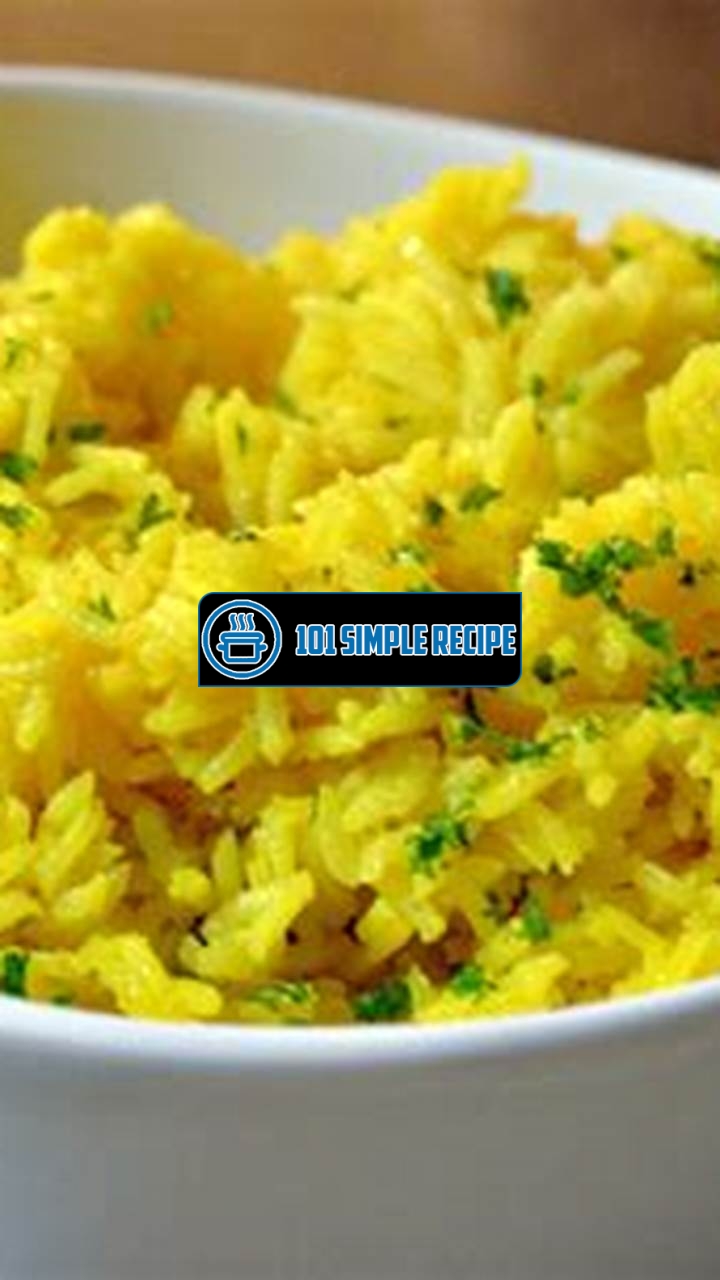Are you considering adding yellow rice to your diet? Yellow rice, also known as saffron rice, is a flavorful dish that can be found in many cuisines around the world. But is it a healthy choice for you? Let’s take a closer look. Yellow rice gets its vibrant color and distinct flavor from the addition of saffron or turmeric. These spices not only give the rice its characteristic hue but also offer potential health benefits. Saffron, in particular, has been linked to mood enhancement and improved digestion. Turmeric, on the other hand, is known for its anti-inflammatory properties. But what else should you know before adding this yellow

The Nutritional Profile of Yellow Rice
When it comes to making healthy food choices, yellow rice often comes to mind. With its vibrant color and delicious flavor, it is a popular dish in many cultures. But is yellow rice really a healthy choice for you? Let’s explore the different aspects of yellow rice’s nutritional value and its impact on overall health.
The Components of Yellow Rice
Yellow rice is primarily made from white rice that has been seasoned and colored with turmeric or saffron. It also often includes other ingredients such as onions, garlic, and various spices. These components not only enhance the flavor but also contribute to the nutritional profile of yellow rice.
Turmeric, the main ingredient responsible for the yellow color, contains a compound called curcumin, which has powerful antioxidant and anti-inflammatory properties. These properties can potentially benefit your health in several ways.
Vitamins and Minerals in Yellow Rice
Yellow rice is a good source of essential vitamins and minerals. It contains B vitamins like thiamine, riboflavin, and niacin, which are necessary for converting food into energy and supporting a healthy nervous system. These vitamins also play a role in maintaining healthy skin, hair, and eyes.
Minerals like iron, zinc, and magnesium are also found in yellow rice. Iron is important for transporting oxygen throughout the body, while zinc supports the immune system and helps with wound healing. Magnesium plays a crucial role in nerve and muscle function and helps regulate blood pressure.
Benefits of Yellow Rice
The nutritional profile of yellow rice offers several health benefits. The antioxidant properties of curcumin in turmeric can help protect against chronic diseases such as cancer, heart disease, and Alzheimer’s. It may also aid in reducing inflammation in the body.
The B vitamins in yellow rice are vital for maintaining energy levels and supporting brain function. They can enhance cognitive abilities, improve mood, and reduce the risk of neurodegenerative disorders like dementia.
Furthermore, the minerals found in yellow rice promote overall well-being. Iron prevents anemia and ensures optimal oxygen supply, while zinc boosts the immune system and aids in the production of enzymes and hormones. Magnesium supports bone health, promotes proper digestion, and helps regulate sleep patterns.
In conclusion, yellow rice can indeed be a healthy choice for you. Its nutritional profile, enriched with vitamins, minerals, and antioxidants, offers various health benefits. So go ahead and enjoy this flavorful and nutritious dish as part of a balanced diet!
Understanding the Process of Making Yellow Rice
When it comes to cooking yellow rice, it is important to understand the traditional method of preparation and its significance. The process involves several steps that contribute to the vibrant color and unique flavor of this popular dish.
The first step is to select the right type of rice. Basmati rice is commonly used for making yellow rice due to its long grains and ability to absorb flavors well. The rice is then rinsed thoroughly to remove any excess starch, which can make the grains sticky.
Next, the rice is cooked in a pot with water. However, what sets yellow rice apart is the addition of turmeric, a spice that gives the dish its distinct yellow hue. Turmeric is a commonly used ingredient in Indian cuisine and is known for its numerous health benefits.
The Role of Turmeric in Yellow Rice
Turmeric is the key ingredient that gives yellow rice its vibrant color. This powerful spice is known for its anti-inflammatory and antioxidant properties. It contains an active compound called curcumin, which has been shown to have a wide range of health benefits.
Curcumin has been linked to reducing the risk of chronic diseases such as heart disease, cancer, and Alzheimer’s. It also has potential anti-cancer effects and may help in managing arthritis and digestive disorders.
Adding turmeric to yellow rice not only enhances its visual appeal but also boosts its nutritional value. The combination of turmeric and rice creates a flavorful and nutritious dish that can be enjoyed on its own or as a side dish.
Additional Spices and Ingredients
While turmeric is the star ingredient in yellow rice, there are other spices and ingredients that can be added to enhance the flavor profile. Common additions include cumin, cinnamon, cloves, and cardamom. These spices not only add depth and complexity to the dish but also offer their own health benefits.
Cumin, for example, aids in digestion and has anti-inflammatory properties. Cinnamon has been shown to help regulate blood sugar levels and reduce inflammation. Cloves are rich in antioxidants and have antimicrobial properties.
Apart from spices, other ingredients such as onions, garlic, and bay leaves are often used to infuse additional flavors into the rice. These ingredients not only contribute to the overall taste of the dish but also offer their own health benefits.
Health Considerations in the Cooking Process
When preparing yellow rice, it is important to consider certain health aspects during the cooking process. Using a minimal amount of oil or opting for healthier alternatives such as olive oil can help reduce the overall fat content of the dish.
Additionally, using low-sodium broth or stock can help control the sodium levels in the rice. This is particularly important for individuals with hypertension or those who are watching their sodium intake.
Furthermore, cooking the rice until it is tender but not overly soft can help preserve its nutritional value. Overcooking can result in the loss of vitamins and minerals present in the grains.
In conclusion, yellow rice is a flavorful and vibrant dish that can be a healthy choice when prepared using the right ingredients and cooking techniques. The use of turmeric and other spices not only adds color and flavor but also offers various health benefits. By understanding the process of making yellow rice and considering health considerations, you can enjoy this delicious dish without compromising your well-being.
The Health Benefits of Consuming Yellow Rice
Discover the various ways in which yellow rice can positively impact your well-being.
Improved Digestion and Gut Health
Consuming yellow rice can contribute to improved digestion and promote gut health. The high fiber content in yellow rice aids in regulating bowel movements and preventing constipation. By ensuring regular and smooth bowel movements, yellow rice helps to maintain a healthy digestive system.
Moreover, yellow rice contains resistant starch, which acts as a prebiotic and provides nourishment to the beneficial bacteria in the gut. These bacteria play a crucial role in maintaining a balanced gut microbiome, which is essential for optimal digestion and overall health. A balanced gut microbiome can also help prevent digestive disorders such as irritable bowel syndrome (IBS) and inflammatory bowel disease (IBD).
Tip: Incorporating yellow rice into your diet can support healthy digestion and gut function.
Anti-Inflammatory Properties
Yellow rice possesses anti-inflammatory properties that can help reduce inflammation in the body. The vibrant yellow color of the rice is attributed to the presence of curcumin, a compound found in turmeric, which is a key ingredient in yellow rice.
Curcumin has been extensively studied for its potent anti-inflammatory effects. It inhibits the activity of inflammatory enzymes in the body, effectively reducing inflammation and associated symptoms. Chronic inflammation has been linked to various health conditions, including heart disease, diabetes, and arthritis. Including yellow rice in your diet can help counteract inflammation and potentially lower the risk of these conditions.
Tip: The curcumin in yellow rice makes it a nutritious choice for reducing inflammation in the body.
Boosting the Immune System
Yellow rice can play a role in boosting your immune system and enhancing your body’s ability to fight off infections and diseases. The turmeric in yellow rice is known for its immune-boosting properties.
Turmeric contains a compound called curcumin, which has antimicrobial, antiviral, and antioxidant properties. These properties help strengthen the immune system by neutralizing harmful free radicals, reducing oxidative stress, and fighting against harmful pathogens.
Furthermore, curcumin has been shown to enhance the activity of certain immune cells, such as natural killer cells and T cells, which are crucial for fighting off infections. By incorporating yellow rice into your diet, you can support your immune system and maintain a strong defense against illnesses.
Tip: Including yellow rice in your meals can provide a natural immune boost and enhance your body’s ability to ward off diseases.
In conclusion, yellow rice offers numerous health benefits, including improved digestion and gut health, anti-inflammatory properties, and a boost to the immune system. Incorporating yellow rice into your diet can positively impact your overall well-being. So why wait? Start enjoying the health benefits of yellow rice today!
If you’re searching for more healthy recipes, you can check out this weight loss recipe that might interest you.
Potential Drawbacks and Precautions of Yellow Rice
Yellow rice is a popular dish known for its vibrant color and delicious flavor. Made from white rice and infused with turmeric, yellow rice is a staple in many cuisines around the world. While yellow rice can be a tasty addition to your meals, it’s important to be aware of the potential drawbacks and take necessary precautions. In this article, we will explore three key aspects to consider before adding yellow rice to your diet: its high carbohydrate content, its impact on sodium levels and blood pressure, and the potential for allergies and sensitivities.
High Carbohydrate Content
One potential drawback of yellow rice is its high carbohydrate content. Carbohydrates are an essential macronutrient that provide energy to fuel our daily activities. However, consuming too many carbohydrates can lead to weight gain and increase the risk of developing chronic conditions such as diabetes and heart disease. It is important to enjoy yellow rice in moderation and balance it with other nutrient-rich foods.
Important Point: While yellow rice can be a delicious addition to your meals, it is crucial to be mindful of your carbohydrate intake to maintain a healthy diet and prevent potential health issues.
Sodium and Blood Pressure
Another aspect to consider when consuming yellow rice is its sodium content and its potential impact on blood pressure levels. Sodium is a mineral that plays a crucial role in maintaining fluid balance in our bodies. However, excessive sodium intake can lead to high blood pressure, which increases the risk of heart disease and stroke.
Important Point: If you have a history of high blood pressure or are trying to reduce your sodium intake, it is advisable to consume yellow rice in moderation and pair it with low-sodium dishes.
Allergies and Sensitivities
Lastly, it’s important to be aware of allergies and sensitivities when consuming yellow rice. Some individuals may be allergic to ingredients commonly used in yellow rice recipes, such as turmeric or certain spices. Allergic reactions can range from mild symptoms like skin rashes or digestive issues to severe reactions like difficulty breathing or anaphylaxis.
Important Point: If you have known allergies or sensitivities, it is crucial to carefully read the label or inquire about the ingredients used in the yellow rice dish before consuming it.
While yellow rice can be a flavorful and enticing addition to your meals, it is essential to understand its potential drawbacks and take necessary precautions. Be mindful of your carbohydrate intake, especially if you are managing your weight or have certain health conditions. Monitor your sodium intake and consider pairing yellow rice with low-sodium dishes to maintain healthy blood pressure levels. Lastly, if you have allergies or sensitivities, read labels carefully and communicate with the cook or restaurant staff to ensure the ingredients used in yellow rice are safe for consumption. By being informed and cautious, you can enjoy yellow rice while making healthy choices for your well-being.
If you’re looking for a unique twist on a classic recipe, you can try this borax ant killer recipe to keep your home pest-free.
Including Yellow Rice in a Balanced Diet
Yellow rice is not only delicious but can also be a healthy choice when incorporated into a well-balanced diet. It is a versatile ingredient that adds both flavor and color to your meals, making it a great addition to any menu. By understanding how to include yellow rice in your diet, you can reap the nutritional benefits it has to offer. Here are some tips on how to incorporate yellow rice into a healthy and varied meal plan:
Pairing Yellow Rice with Nutrient-Rich Foods
To make your yellow rice even more nutritious, you can pair it with nutrient-rich foods. This combination will enhance the overall nutritional value of your meal. Consider adding some lean protein sources, such as grilled chicken or boiled eggs, to your yellow rice. Protein is essential for muscle growth and repair. Additionally, include a variety of colorful vegetables like spinach, bell peppers, and carrots. These vegetables are packed with vitamins, minerals, and fiber, which contribute to a well-rounded diet. Don’t forget to add a source of healthy fats to your meal, such as avocado or olive oil. Healthy fats provide essential nutrients and help with nutrient absorption.
Portion Control and Moderation
While yellow rice can be a healthy choice, it’s important to practice portion control and moderation. Portion sizes should be appropriate for your individual needs and goals. One serving of yellow rice is about 1/2 cup or 100 grams, which provides approximately 150-200 calories. Be mindful of your overall calorie intake and adjust your portion sizes accordingly. Remember that a balanced diet consists of a variety of foods, so it’s important not to rely solely on yellow rice for all your nutritional needs. Incorporate other wholesome foods into your meals to create a well-rounded diet.
Alternative Cooking Methods
Traditionally, yellow rice is made by cooking white rice with turmeric or saffron, giving it its vibrant yellow color. However, you can experiment with alternative cooking methods to make your yellow rice even healthier. For example, you can use whole grain rice instead of white rice. Whole grain rice contains more fiber and nutrients compared to its refined counterpart. Additionally, you can add vegetables like peas, corn, or diced tomatoes to increase the nutritional value of the dish. These additions not only add more nutrients but also provide extra flavor and texture. Experimenting with different cooking methods can keep your yellow rice exciting and enjoyable.
Making yellow rice a regular part of your diet can bring a range of nutritional benefits. It is a good source of carbohydrates, which provide energy for your body. Carbohydrates are essential for proper brain function and physical activity. Yellow rice also contains small amounts of protein and fiber, which contribute to overall nutrition and satiety. However, it’s important to note that yellow rice should be consumed as part of a balanced meal plan. Consult with a healthcare professional or registered dietitian to determine the best portion sizes and overall dietary recommendations for your specific needs.
For a delicious and wholesome meal, you should try making this Nature’s Recipe wet dog food recipe that your furry friend will love.
Thank you for taking the time to read our article on whether yellow rice is healthy. We hope that you found the information informative and helpful in making dietary decisions. If you have any further questions or would like to learn more about other health-related topics, please visit our website again soon. We strive to provide valuable content that empowers our readers to make informed choices about their well-being.
Frequently Asked Questions
Here are some frequently asked questions about yellow rice:
| No. | Questions | Answers |
|---|---|---|
| 1 | Is yellow rice a healthy option? | Yellow rice can be a nutritious choice when consumed in moderation. It contains essential nutrients like vitamins, minerals, and fiber. However, it is important to be mindful of portion sizes and the ingredients used in its preparation. It is always best to consult with a healthcare professional or registered dietitian for personalized dietary advice. |
| 2 | Why does yellow rice have its color? | Yellow rice gets its color from the addition of spices like turmeric or saffron. These spices not only impart a vibrant yellow hue but also provide potential health benefits due to their antioxidant and anti-inflammatory properties. |
| 3 | Can yellow rice help with digestion? | The fiber content in yellow rice can aid in digestion by promoting regular bowel movements and preventing constipation. Additionally, certain spices used in yellow rice, such as cumin or ginger, have been traditionally used to support digestive health. |
| 4 | Is yellow rice suitable for individuals with dietary restrictions? | Yellow rice can be adapted to meet various dietary needs. For individuals with gluten intolerance or celiac disease, using gluten-free rice and spices ensures it remains free of gluten. Vegan or vegetarian versions can be prepared by using vegetable broth instead of animal-based broth. However, it is essential to read ingredient labels and consult with a healthcare professional if you have specific dietary concerns. |
| 5 | How does yellow rice fit into a balanced diet? | Yellow rice can be part of a balanced diet when combined with a variety of other nutritious foods. Incorporating lean proteins, vegetables, and healthy fats alongside yellow rice ensures a well-rounded and nourishing meal. It is always important to prioritize the overall nutritional quality of your diet and practice portion control. |
| 6 | Are there any potential health concerns associated with yellow rice? | While yellow rice can be a healthy choice, it is important to be cautious of the added sodium content in pre-packaged or restaurant-prepared versions. Excessive sodium intake is linked to high blood pressure and other health issues. Opting for homemade yellow rice using low-sodium ingredients or controlling portion sizes can help mitigate these concerns. |
Is Yellow Rice Healthy?
In conclusion, yellow rice can be a nutritious and flavorful addition to your diet when consumed in moderation. It offers essential nutrients and potential health benefits from spices like turmeric or saffron. However, it is crucial to be mindful of portion sizes and the sodium content in pre-packaged or restaurant-prepared versions. Opting for homemade yellow rice using low-sodium ingredients and incorporating it into a well-balanced diet can contribute to overall dietary health. Remember to consult with a healthcare professional for personalized dietary advice. Thank you for reading, and we hope to see you again on our website for more informative articles!
Jump to Recipe
Yellow Rice Recipe

Learn how to make delicious and nutritious yellow rice.
- 2 cups long-grain rice
- 1 teaspoon turmeric powder
- 1/2 teaspoon ground cumin
- 1/2 teaspoon paprika
- 1/4 teaspoon salt
- 4 cups vegetable broth
- In a large saucepan, combine the vegetable broth, turmeric powder, ground cumin, paprika, and salt. Bring to a boil.
- Add the rice to the boiling broth mixture. Stir well, reduce heat to low, and cover the saucepan with a lid.
- Simmer the rice for 20-25 minutes, or until all the liquid is absorbed and the rice is cooked.
- Fluff the cooked rice with a fork and serve hot as a side dish or as a base for your favorite recipes.






